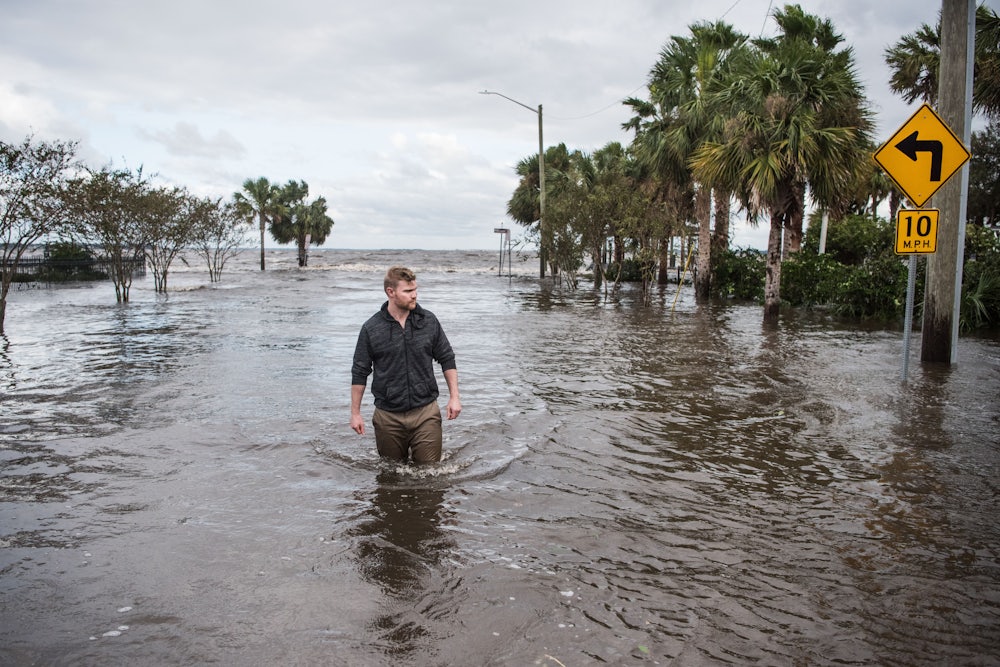Hurricane Irma caused massive sewage overflows, highlighting the twin dangers of an aging infrastructure and climate change.
In the days and hours before Hurricane Irma slammed into Florida, its residents were treated to copious media speculation about nightmare scenarios. This monster storm, journalists said, could bring a 15-foot storm surge, blow roofs off of buildings, and cause tens of billions of dollars in damage. But perhaps no scenario seemed more dire than the one Quartz warned about the day before Irma made landfall: “Hurricane Irma will likely cover South Florida with a film of poop.”
Quartz’ apparent hyperbole turned out to be an understatement. Pollution reports submitted to Florida’s Department of Environmental Protection show that, due to power outages and flooding caused by Irma, human waste has been spilling into streets, residences, and waterwaysacross the entire state. At the time of this article’s publication, at least 113 “Public Notices of Pollution” had been submitted to the DEP. Combined, those discharge reports showed more than 28 million gallons of treated and untreated sewage released in 22 counties. The total amount is surely much more; at least 43 of those reports listed either an “unknown” or “ongoing” amount of waste released, and new reports continue to roll in—sometimes as many as a dozen per hour.
In other words, Irma was a literal shitstorm. But it’s no laughing matter. Sewage spills pose a major threat to public health, and they’re likely to become more common due to two increasingly connected crises facing America: an aging infrastructure and climate change.
The spills in Florida range from benign to revolting. In some cases, a few hundred gallons of raw sewage burst from manholes into non-flooded areas and were quickly cleaned up. But in Miami, the city’s South District Wastewater Treatment Plant reported a six-million-gallon sewage spill that reached Biscane Bay, a state aquatic preserve. While the report said the area was cleaned and disinfected, it also says the public was not notified and the sewage was not recovered. In Seminole County, north of Orlando, a sewer overflowed for six hours, spilling two million gallons. More than 300,000 gallons flowed into Stevenson Creek, which the Tampa Bay Times reports is already “one of Pinellas County’s most polluted bodies of water.” The St. John’s River in Jacksonville has seen at least 130,000 gallons of sewage released into its tributaries. And in Volusia County, which holds Daytona Beach, a two-million-gallon spill of treated sewage has seen “no cleanup efforts” so far, according to a notice.
The DEP emphasizes that these notices contain estimates. “It should be noted that these are initial incident reports, and that information on the volume of wastewater released during an event like Hurricane Irma may fluctuate depending on the initial estimates and the overall amounts that are able to be recovered after a spill,” Florida DEP spokesperson Dee Ann Miller said in an email. “Frequently these numbers continue to be refined as additional information becomes available.” It will likely take days, if not weeks for the full extent of sewage overflows and contamination in Florida to be assessed. But state officials aren’t taking any chances. Bloombergreports that “utilities across the state warned residents to boil water before drinking it,” and the Environmental Protection Agency “has deployed specialists to Florida to help get wastewater systems back online.” The DEP is urging Floridians to stay out of floodwaters, and to look for warning signs posted by local authorities about accidental sewage releases.
In other words, though the state is still determining the extent of the pollution, there’s widespread agreement about the risk to human health. “Public health is the most imminent threat with these releases,” said Mary Grant, the director of Food and Water Watch’s Public Water for All campaign. “Contamination of water leads to people being exposed to disease.” Dr. Valerie Harwood, whose University of South Florida lab researches water quality microbiology, said humans exposed to raw or poorly treated sewage could experience a number of gastrointestinal problems or a nasty virus. “You can get nausea, vomiting, diarrhea … the noroviruses, better known as cruise ship viruses,” she said. The polluted water may also contain bacterial pathogens like salmonella and giardia.
Harwood said exposure risk is short-lived in most cases, so long as contaminated water is flushed out into larger sources—like the Biscane Bay, which she said would likely be fine despite welcoming six million gallons of sewage. “You wouldn’t have wanted to be in the water when [the spill] happened, but it’s gone now,” she said. The real risks come when human waste reaches stagnant floodwaters, retention ponds, or slow-moving streams. Texas is dealing with this now, after Hurricane Harvey caused massive sewage overflows in Houston. Scientists are finding that stagnant floodwaters there contain startling amounts of human fecal matter and E. coli. If any mucous membranes or open wounds come into contact with that bacteria—or if people who touch it fail to wash their hands before eating—it could cause bloody diarrhea and other unpleasantness.
To some extent, sewage overflows are to be expected during big storms. “Those who know how these systems work understand that when this amount of water comes into the system, there’s absolutely nothing that can to be done except to let the water go,” Harwood said. “If we engineered the plants to accommodate water overflows from a hurricane, it would cost so much that people would be very angry. It’s a trade-off between uncommon events when they occur that pose a health risk, versus having a really expensive overcapacity that’s not used 99 percent of the time.”
At the same time, the nation’s sewage infrastructure—particularly Florida’s—is in worse shape than it should be, making it more susceptible to accidents and overflows. As The New York Times reported last week, “Much of the state’s infrastructure is now nearing the end of its useful life.” Last year, the EPA said $17 billion would be needed over the next two decades just to maintain Florida’s existing systems. And that’s nothing compared to the $271 billion the EPA says is needed to maintain and improve the aging, crumbling wastewater infrastructure across the country. What’s more, climate change is slowly making the problem worse—not only because of more intense rainfall, but because rising seas cause more leaks from coastal septic systems.
The Trump administration has partly acknowledged this problem. Though the president’s proposed budget nearly demolishes every other aspect of the EPA, it would slightly increase, by half of one percent, funding for the agency’s State Revolving Funds, which provide loans for construction and improvement of wastewater facilities. And Trump signed a bill in May that increases, also by half of one percent, the amount the EPA is able to lend states and municipalities for sewage system improvements.
But environmental advocates and publicly owned water utilities contend that these efforts aren’t nearly enough. When adjusted for inflation, federal funding for water infrastructure has fallen 74 percent since 1977—so increasing State Revolving Funds by half a percent, as Trump as proposed, “is insufficient to the need,” said Food and Water Watch’s Mary Grant. Trump has also proposed eliminating a separate programfor rural wastewater projects and using the minuscule increase in State Revolving Funds to cover those projects. And because Trump is hostile to any policy that takes climate change into account, there’s no plan to make these sewage systems more resilient to the impacts of global warming. “Trump’s approach is not the right one,” Grant said. “We need direct federal spending in our water and sewer systems.” Until that happens, we’ll continue to be knee deep in shit.


No comments:
Post a Comment